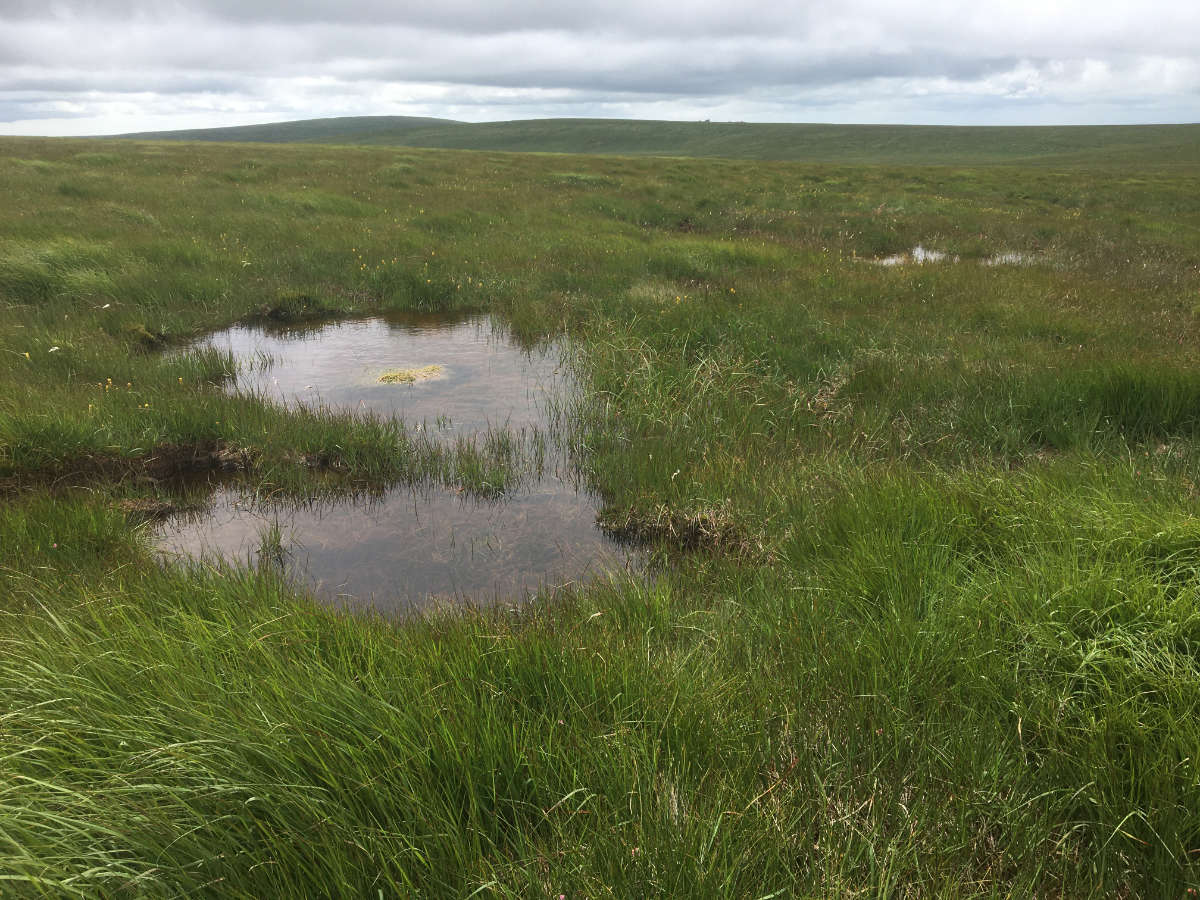
Peat is an accumulation of slowly decaying plant matter formed in cool wet conditions. It is a remarkable substance and one of the most important stores of carbon on the planet.
According to the International Union for Conservation of Nature (IUCN), globally the remaining area of near-natural peatland (more than three million km²) contains more than 550 gigatonnes of carbon. This is 42 per cent of all soil carbon, and exceeds the carbon stored in all other vegetation types, including the world’s forests.
On Dartmoor, as elsewhere, peat started to form shortly after the end of the last ice age 12,000 years ago. The rate of deposition altered with changing climates, with more being laid down in wetter times such as towards the end of the Bronze Age, but on average each year adds one millimetre to its depth. The deeper the peat, the greater its importance in storing carbon. Peat over 40cm deep covers around 15,800 ha of Dartmoor and it is estimated this stores 13.1 megatonnes of carbon.
For this reason alone, the peat in the National Park is probably its greatest single asset.
And this is just the carbon; peat is also of high value for its wildlife. The habitat most closely associated with deep, wet peat in the uplands is blanket bog. This is well known to all walkers on the high moor; it’s the wet, jelly-like land that makes wellies the favoured footwear at any time of year. Blanketing the ground, in the valley mires and on the gentle slopes amongst the grasses are the rich greens and reds of the sphagnum moss. In high summer the bogs come alive with the yellow blossoms of asphodel, the white cotton grasses and tiny carnivorous sundews. These places provide a home to specialist animals such as dunlin and snipe, both wading birds that enjoy the wet conditions. It’s a rare habitat globally.
However, sadly, peat is an asset that’s in a very poor condition. To understand why, it’s worth looking first at how blanket bogs form.
Peat forms when plant matter is unable to decompose completely. This occurs in naturally cool, wet areas such as Dartmoor, where rainfall is particularly high. In such watery conditions the normal rates of plant decomposition are slowed because of lack of oxygen. Organic matter is laid down faster than it can decompose, and this is how the peat forms. One of the key constituents in the formation of the bogs are the sphagnum mosses that thrive in these wet conditions. The roughness and water-retaining ability of this mossy surface vegetation naturally slows the flow of water off the bog. Also, the high moor’s only water input is from overhead rain – which makes it very low in mineral nutrients (hence the need for the sundews to supplement their diets by ensnaring flies).
So the key thing with peat is that it needs to be constantly forming, and crucially, to achieve this, it needs to be wet. Anything that hinders its formation and its “wetness” is a problem. Historically two things have done this: firstly it’s been extracted as a resource, and secondly, it’s been ‘managed’ in a way that causes the peat to dry out and erode.
Deep peat damage
Peat has been dug, or ‘cut’, on Dartmoor for hundreds of years. It’s a handy fuel source, akin to coal. It was used domestically, and it fuelled the tin industry through its boom times, particularly in the Middle Ages. In a charter of 1201, King John confirmed the privilege of ‘digging tin and turves for smelting at all times’ to Dartmoor tinners. Peat was converted into charcoal by specialist workers known as carbonarrii. In the 19th and early 20th century, there was also experimentation in using peat to distil naphtha oils for use in gas production or for the manufacture of candles.
The peat was also cut to drain land for agricultural improvement, and in places it was cut to create the well-known Dartmoor ‘peat passes’: drier tracks through the blanket bog. The peat on the northern part of the moor was also ‘extracted’, in an explosive manner, by the military, via artillery, mortars and grenades.
The extent of historical peat cuttings is quite significant, as can be seen in the map below, where they are shown in purple. In short, the peat on Dartmoor has been much exploited.
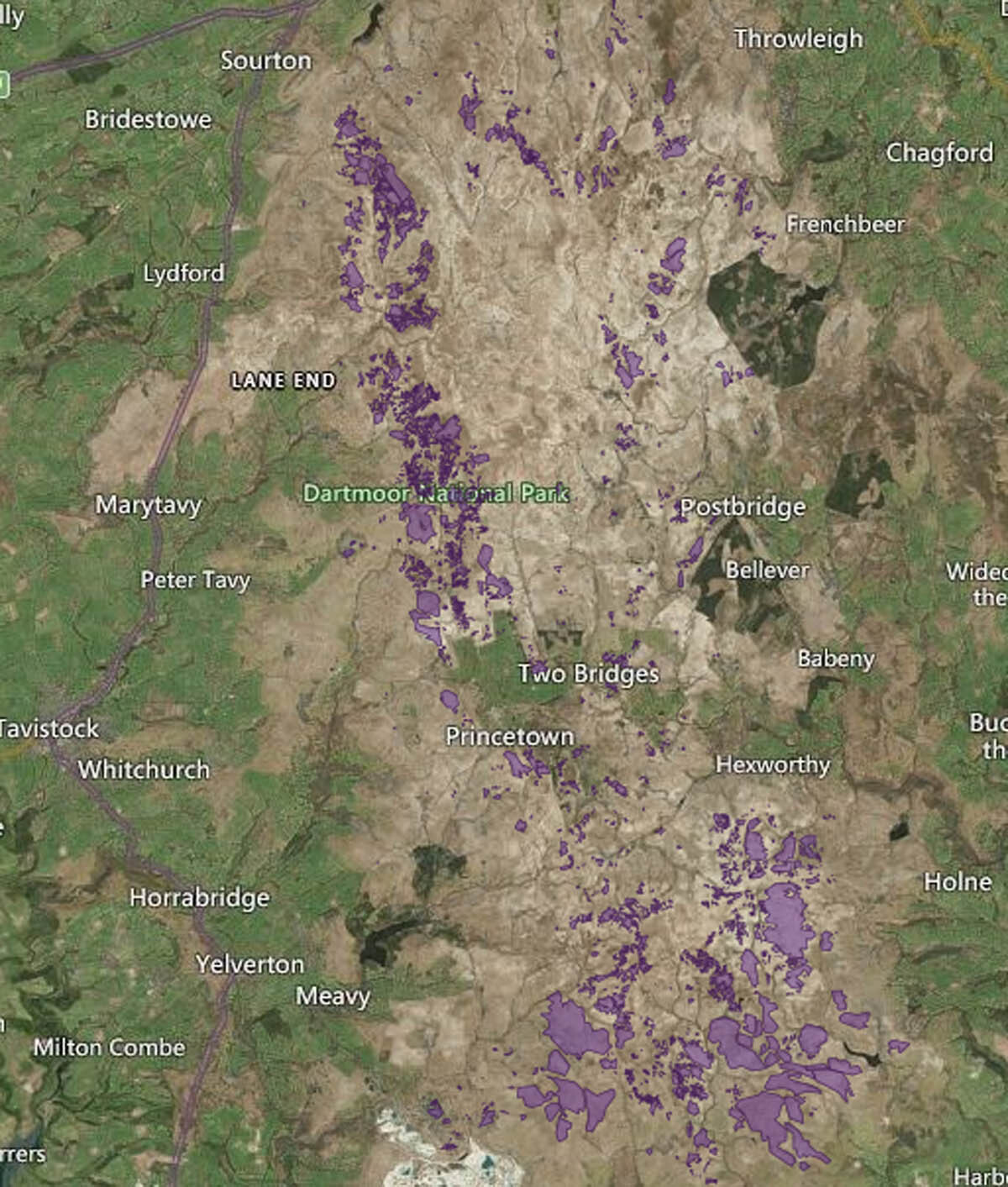
Although the cutting of peat is perhaps the most obvious cause of damage, peat has also been mis-managed in other ways. Wherever peat is exposed – wherever there is bare peat – it will dry out and erode. The areas of bare peat (or ‘peat pans’ as they are known) on the northern part of Dartmoor are shown in black on the map below.
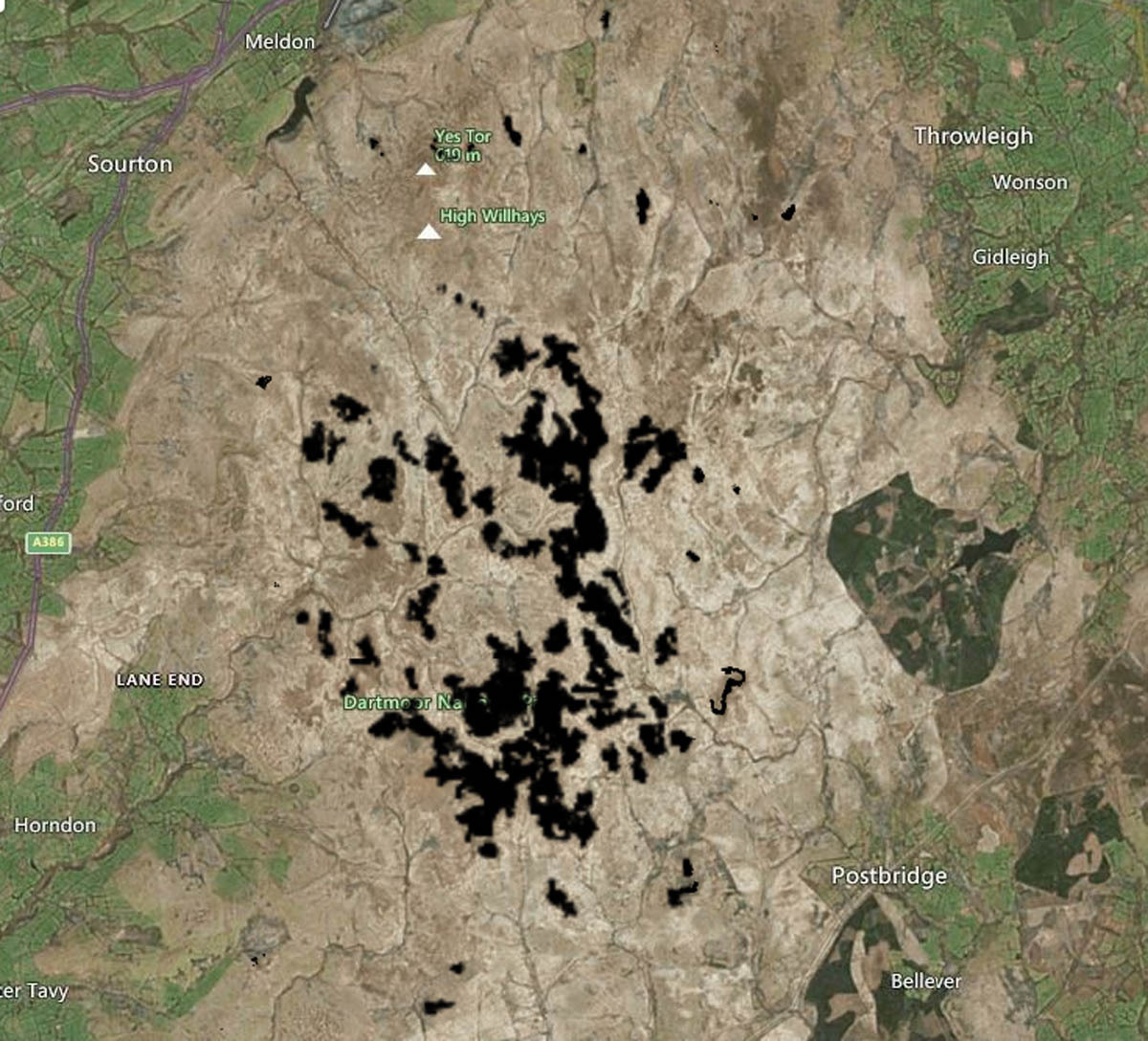
Bare peat is caused largely by human activity. Peat can be exposed simply through overgrazing. From the 1970s through to the late 1990s much of Dartmoor was heavily overgrazed, and even today, when livestock numbers are lower, there are still parts of the moor that are under pressure from too many grazing animals.
Related to grazing is the exposure of bare peat through fire, particularly regular and deliberate burning by farmers, known as ‘swaling’ on Dartmoor. Swaling is an ancient tradition, going back hundreds, if not thousands, of years. It is done to encourage the growth of grasses for livestock to eat. However, if it is doneintensively and regularly it is a disaster on deep peat. Not necessarily because it burns the peat itself (although that can happen), but because regular ‘burns’ change the surface vegetation, from peat-forming plants such as the mosses that blanket the ground, to an open mix of grasses and bare peat.
Carbon catastrophe
Once exposed, the direct forces of warm sunlight and cold nights on the peat’s surface causes it to dry and oxidise, emitting significant amounts of carbon (CO₂) into the atmosphere. To put this into a global perspective, according to the IUCN, “Damaged peatlands contribute about 10 per cent of greenhouse gas emissions from the land use sector. CO₂ emissions from drained peatlands are estimated at 1.3 gigatonnes of CO₂ annually. This is equivalent to 5.6 per cent of global anthropogenic CO₂ emissions.”
And in the UK context, according to the government’s November 2021 Net Zero Strategy, “In 2019, peatlands emitted 4 per cent of UK net greenhouse gas emissions.”
Then also, through the action of rain, peat is lost into our rivers, washing off rapidly – without the rough surface vegetation to hold it back – and causing deep erosion gullies and ‘hags’ (mounds of uneroded peat between erosion sites). These gullies – particularly evident on the high moor – in turn lower the water-table locally, causing more drying and exposure in a vicious cycle that leads to the bogs becoming less and less able to function and hold water. You can see the extent of erosion gullies near Hangingstone Hill marked in yellow and red on this map:
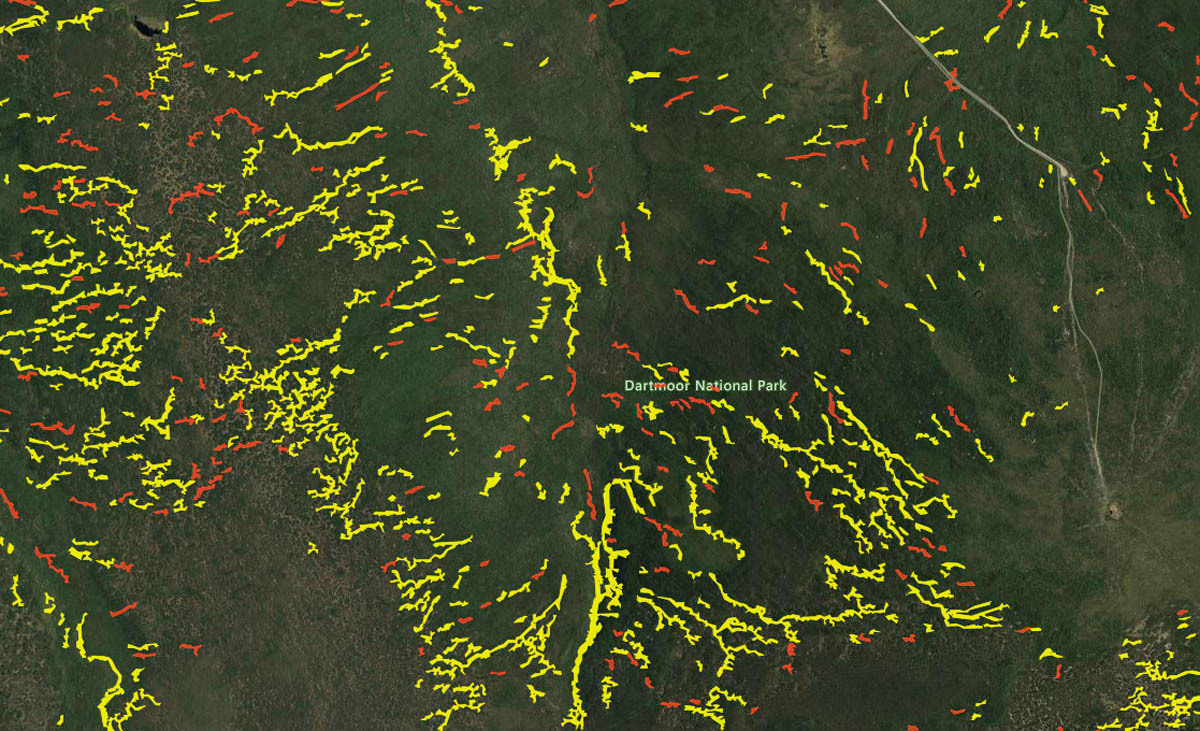
This breakdown in the ability of the bogs to slow the flow of water leads inevitably to higher rates of flow in the rivers that lead off the high moor, increasing the risk of flooding. Additionally, it costs all water-users millions of pounds through water charges, to clean the water of the peat material.
It’s clear, in summary, that Dartmoor’s peatlands are in poor condition. But restored, they could be hugely important locally and nationally, in terms of storing carbon, benefits to biodiversity, and as a ‘nature-based solution’ for issues such as flooding and the provision of clean water. The UK’s Natural Capital team stated in 2019 that restoring just “55 per cent of peatlands to near natural condition is estimated to have a present value of approximately £45bn to £51bn.”
It’s impossible for the UK to achieve its net zero ambitions without extensive peatland restoration.
The solution
The theory is simple. The peatland needs to be ‘rewetted’. It needs to be brought back into a condition where the natural surface vegetation is restored and the bare peat covered. To do this, the water must be prevented from rapidly running off through the erosion gullies. And to achieve this, the gullies need to be blocked with dams. Just slow the flow. And that’s it!
The practicalities, though, are enormously challenging. The first challenge is that the work is being done in a very remote place, so the people and machinery that are building the dams need to find a way to get in. To avoid disturbance to wildlife during spring and summer when birds and other creatures are breeding, the work has to be done in autumn and winter – the toughest time of the year to be on the high moor. The machinery has to be of a special type that avoids putting huge pressure on the ground and potentially adding to the peat’s problems, and indeed the operators’. This means using ‘wide track’ machines that are remarkably light on the ground (pound for pound, they exert much less pressure per square inch than you or me).
The work also has to consider archaeology. Dartmoor is one of the finest bronze age landscapes in Europe, and for this reason, restoration efforts must involve qualified professional archaeologists to ensure nothing is damaged. But it’s also worth remembering that the peat itself is important archaeologically. The paleoenvironmental record contained in peat is very important, and this is lost as the peat degrades. The peat also physically supports many features classed as ancient monuments, and erosion is a real threat to their stability.
The work also needs to consider unexploded bombs. The high moor has been used for military training for a hundred years, and this has left a deadly legacy. So before any work takes place, the land is carefully checked.
Peatland restoration is a huge task. To restore just one area of peat requires putting dams across many, many erosion gullies. The ‘before’ and ‘after’ illustration below demonstrates this: each black dot on the second diagram is one of the pools that forms behind a peat dam.

We’ve only just begun
Despite the challenges, peatland restoration work is underway. On Dartmoor it is being delivered through the South West Peatland Partnership, formed in 2009, and locally led by Dartmoor National Park Authority, Natural England, the Duchy of Cornwall, Dartmoor Commoners’ Council, the Environment Agency and South West Water, and informed by the very best science through the University of Exeter.
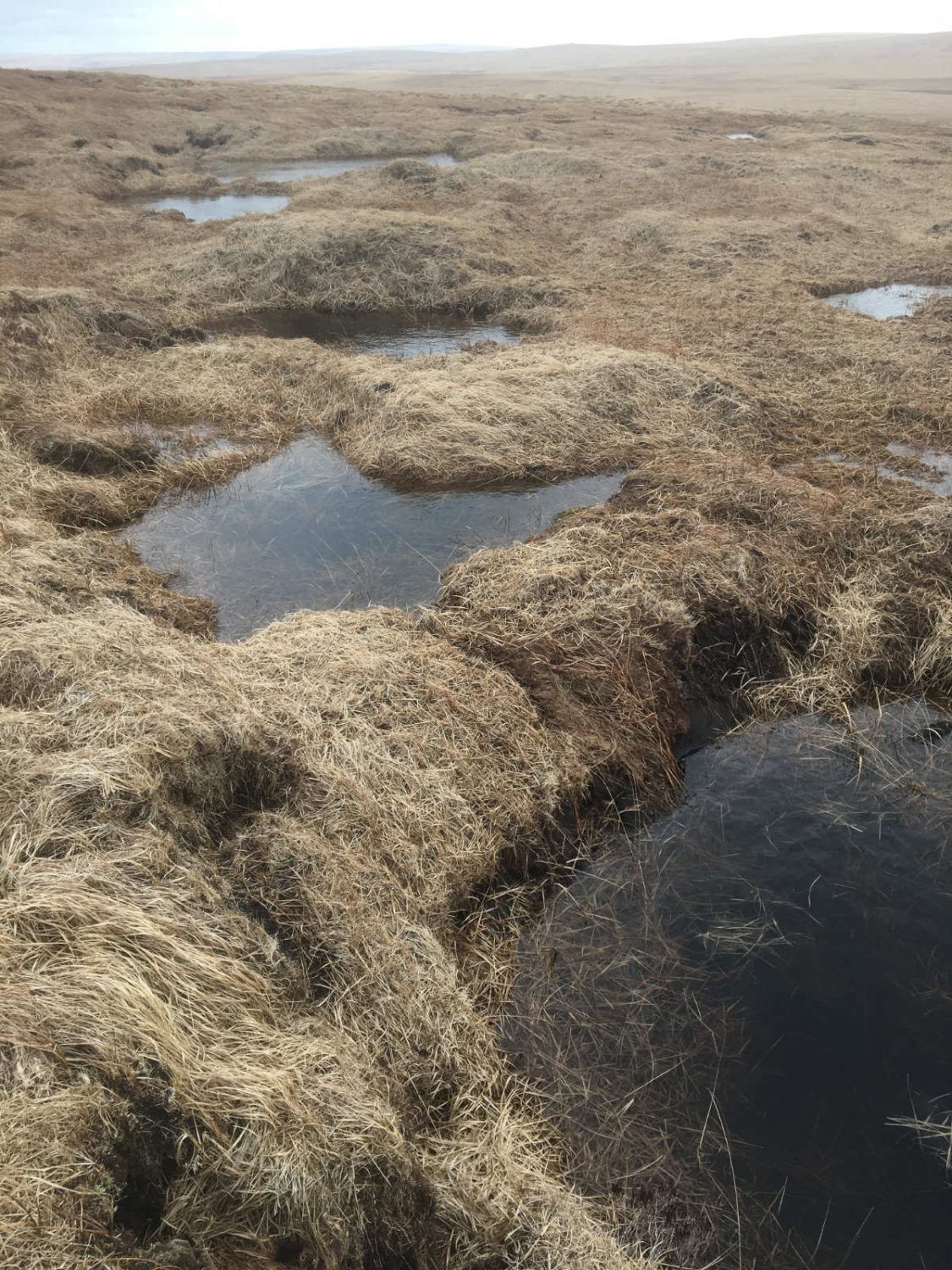
Since work started in 2009, 385ha (hectares) of Dartmoor peatland has been restored, and a further 131ha will be restored during the winter of 2021/22. In 2021 the project was awarded a further £8m by the Government, with the target of restoring 931ha. It is estimated that this will save 356,186 tonnes of CO₂ equivalent over 50 years. This is enormously good value for money, especially when compared to other means of decarbonising the economy. The presence of the blanket bogs as a nationally important habitat also underpins the many farm environment schemes on the moor, making sure that the peat has a real value to the local economy and its farmers and land managers.
All round, peat restoration is one of the cheapest ways by which we can mitigate climate change, restore nature, support the local economy and ensure water quality. Who wouldn’t want to make the most of that! However, the hard work and restoration efforts to date represent just 2.4 per cent of the total deep peat on the moor. We have to do more – a lot more – and provide the necessary money and resources.
Dartmoor is loved for many things: its landscapes, its rural traditions, its archaeology and the space it provides for millions of people to escape into the open air. This was the driving reason for Dartmoor being declared a National Park in those heady and optimistic post war years when people demanded a better life for their sacrifices in WW2.
A better life for future generations rests on the decisions we make now about tackling climate change, the biggest existential threat any of us have ever faced. We must make the right choices, and on Dartmoor that means getting on and restoring all the peatland. National parks, landscapes, rural traditions, archaeology, space, mean nothing on a dead planet.




